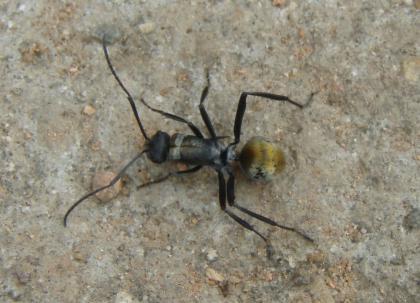2: Spiny Ants and Other Animals
Over a week in the jungles of the Australia Wet Tropics and lots of ants! Although we did stay in a hotel for the first couple of days to visit with colleagues at the university, most of our time in Australia has been spent sleeping in a tent. For this first week, we’ve focused on a site in Murray Upper National Park. Not only is it close to a beautiful rainforest, but it’s also a short hike to a waterfall.
Two of my favorite things about camping in the rainforests of Queensland are: 1) falling asleep to the sound of the Long-Nosed Bandicoot, a nocturnal insect-feeding marsupial about the size of your average pet cat, (it scratches around in the leaf litter near the tent) and 2) waking up to the calls of the Laughing Kookaburra, a medium-sized, blue-and-white bird (see Photo #1 below).
Not only does the “song” of the Laughing Kookaburra sound like a person laughing, but also, once one bird begins to “sing,” then all the others in the area join in, resulting in a chorus of laughing birds. To get an idea of what they sound like, click on the sound link on the right side of the Laughing Kookaburra Wikipedia page.
Although there have been many interesting plants, animals, fungi, and forests to see, the ants are why we came, and there’ve been plenty to collect. Since ants live in colonies, where you find one ant, you’re likely to find more. This means that once I spot a single ant, I must try to figure out where the rest of the colony is nesting. To find ants, I sift through the leaf litter on the ground, snap open dead twigs on trees, look under rocks and rotten logs, and look for ants crawling on trees and vegetation. To see images of how I collect ants, check out my Tools Photo Gallery online.
Once I’ve located a colony or nest of ants, I always try to collect 5-30 individuals, placing them into a vial or tube filled with a preservative like alcohol (see Photo #2 below). The alcohol quickly kills the ants and preserves both their outsides (for microscope identification back in the museum) and the DNA stored inside their cells (for molecular research back in the laboratory). Since I only collect 5-30 individuals, this ensures that the ant colony as a whole continues to live and contribute to the ecosystem where it was found.
Although there are many interesting ants in Queensland, Australia, two of my favorite species are “spiny ants” (Polyrhachis spp.) and “green tree ants” (Oecophylla smaragdina)—We’ve fortunately had the opportunity to collect lots of both. By the way, “spiny ants” (see top photo) get their name because most of the species in this group have spines on the back of the middle part of their body. They can be a variety of colors, from solid shiny black to fuzzy orange.
These spiny ants are the species I’m focusing on for my research. They can be found living in a huge variety of microhabitats—in the soil, in rotten logs, and in the rainforest treetops or canopy. This variation in their habitat may help us to predict how different strategies allow a species to persist during climate changes.
Specifically, I’m working to determine if, during drier climatic cycles, the diversity of tree-dwelling Polyrhachis species is more affected than the diversity of soil-dwelling Polyrhachis species. Based on my past research in the AWT, I expect to find that the soil-dwelling species are buffered because of their access to ground water.
From what I’ve seen so far, the soil-dwelling species seem to dig their nests deeper and deeper towards the receding groundwater during droughts, which allows their populations to survive and continue to diversify even in times of stress. To see what an underground ant nest actually looks like, take a look at Photo #3 below from Dr. Walter Tschinkel, a colleague of mine.
Once I can do DNA testing on these species and trace their ancestry, I expect to confirm that ground-dwelling Polyrhachis species have a steadily branching family tree—in other words, their buffered microhabitat has allowed them to remain consistently diverse through time, without the same level of spikes and dips in speciation that we see in Polyrhachis ants who live in more fragile, above-ground habitats.
For these canopy-dwelling Polyrhachis species, I expect DNA testing to reveal that they have a more “severely pruned” family tree—one with long, thin branches that show spurts of population growth and diversity only at the tips. In other words, as the climate dried out and caused the disappearance of their microhabitat, many canopy-dwelling species became extinct. Just a few managed to survive, expanding and diversifying only when the climate had recovered enough to support rebounding rainforests, flush with new habitats and food sources.
So how does this kind of information help us? Ant genetics allows us to create a model for how ants and other related species living today (such as wasps and bees) will likely respond to climate change, and where in each ecosystem we can expect to see species extinction occur first and most dramatically. Armed with this information, we can design conservation strategies that more accurately target the rainforest areas that are facing the greatest threats from global warming today.
More cool ant stories to come soon,
Dr. Corrie Moreau






